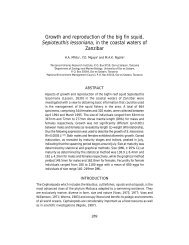Population connected to sewerage infrastructure. The population of Mombasa served bywater-borne sewerage is 15% (Mwaguni and Munga, 1997). Other sources quote a figure of10% (Bambra 1998, UNDP – World Bank, Water and Sanitation Program September 1998).In the City of Mombasa only one third of the area of the Island is connected to water-bornesewerage. Except in some parts of Changamwe, the rest of the remaining Divisions of theDistrict are not sewered.Creeks. Mombasa Island is surrounded by a number of Creeks: Tudor, Makupa, Junda,Kilindini and Port Reitz. By their nature, creeks create steep cliffs that contributed to theformation of deep harbours. The port of Kilindini in Mombasa is of great importance not onlyto Kenya and East <strong>Africa</strong> but also to other land locked countries of central <strong>Africa</strong>.Mangrove Forests. Mangrove forests are the only gazzetted forests in Mombasa District.They cover a total area of 3059.4 ha; Port Reitz 1017.5 ha. Tudor Creek 1321.4 ha. andMtwapa Creek 720.5 ha.Water Resources. There are no rivers of any major significance in Mombasa District. Watersupply to the district comes from sources outside the District but within the Province and thesupply does not meet the demand. There is a large potential for groundwater in the District tosupplement the shortfall. Groundwater is tapped through shallow wells and boreholes but thewater is often either saline, highly mineralized or if fresh, contaminated from pit latrines orseptic tank soakage pit systems typically used for the disposal of sewage in large settlements.As a result, the supply of surface and ground water comes from sources outside the District.Existing Wastewater Management Infrastructure. There are two treatment plants that werebuilt to serve specific areas of the District. One is located on Mombasa Island and the otherin Changamwe Division. The treatment plant on the Island has been out of use for manyyears, and domestic wastes from the sewered population enter the marine environmentuntreated. The plant in Changamwe has also been out of use for a long time, has since beenre-designed and is now under construction to serve a larger population. This plant, to becommissioned soon, will greatly improve the sewage management in Mombasa. For the restof the population, the management of human wastes is by the use of pit latrines and septictank-soakage pit systems. 15% the population relies on septic tank/soakage pit system while72% use pit latrines. The responsible authorities are over-strained and under-funded andcannot provide regular emptying services to the rapidly growing urban population and who aretherefore left to cope with unsanitary practices. Tourist hotel establishments use septic tanksoakagepit systems for human wastes, although some of them have installed their ownsewage treatment plants.Wastewater Hot Spot Pollution Locations• Kipevu in the Kilindini Creek and Port Reitz Creeks, which receive both domesticsewage and industrial effluents, discharges. Due to the proximity of the industrial area tothe natural drainage basin of the Mombasa Island and the west mainland in Changamwe,most of the pollution load from industrial effluents pour into the Kilindini and Port ReitzCreeks. The Creek waters also receive large volumes of domestic sewage from theChangamwe Division, with Kipevu being the main hot spot.• Mtwapa Creek and the Kizingo sewage outfall in the Tudor Creek in which domesticand institutional sewage are discharged from Shimo La Tewa GK Prison.• Kibarani Dumpsite on the edge of Kilindini Creek is another major hot spot area.Pollution Loads and Pollutants (Coliform Bacteria, BOD, COD, Heavy Metals, Etc.)The main pollutants, according to measurements of Coliform Bacteria, BOD, COD and HeavyMetals carried out by Mwaguni and Munga in 1997 in the marine environment and groundwater sources in Mombasa, are BOD and Suspended Solids (SS) from domestic andindustrial sewage. Domestic sources account for 18% and industrial for 67% of BOD loadsand 10% and 55% of SS loads, as shown below. No comprehensive studies have beenconducted since 1997. Subsequent spot-check analyses indicate that the conditions tend toget worse.Final Draft Report – Cost Benefit Case StudiesGPA Strategic Action Plan on Sewage, October, 200016
Table 3: Summary of pollution loads from Mombasa District.Source BOD SS Oil N P HM OtherDomesticSewageBeach hotelsStorm waterSolid wasteIndustrialwasteShip waste *Livestockwaste4369(18.0%)100 (04%)522 (2.2%)1846(7.6%)16249(67%)14 (0.1%)1161(4.8%)3964 (10%)85 (0.2%)4447(11.3%)-21837(55.2%)11 (0.0%)9180(23.2%)-----103-622 (41.9%)18 (1.2%)166 (11.2%)-45 (3.0%)2 (0.1%)630 (42.5%)94 (19%)2 (0.4%)11 (2.3%)-6 (1.3%)0.2 (0.0%)364(76.3%)Cr0.25Cu0.001fe 2.9Ni0.005Zn0.11Phenol0.01S:0.12Totals 24233395241031483477(100%)(100%)(100%)(100%)100%* estimated domestic wasteSource: Mwaguni & Munga 1997Table 4: Microbial Contamination & Nutrient Levels-Mombasa Distr. Inshore Water AreasAreaBODmgO/lColiformper 100mlE. Coli per100mlNO ug-asN/lPO ug-as N/lKilindini / Port Reitz CreekTudor Creek0.2-2.40.4-4.00 –1800+0 –16000-5500 – 140.2-4.00.6-7.21.3-2.30.9-5.7Source: Mwaguni & Munga 1997Table 5: Sewage Discharge RatesDischarge Rates –cubic meters per daySource Design Flow Current Flow ProjectedChangamwe Stage 1 17 100 Unknown 51 300Kizingo 31 400 Unknown 94 200Source: Mwaguni & Munga 1997Fresh water Quality. Mombasa District has no surface water resources of its own. TheDistrict depends on surface water supplies from Baricho in Malindi District. These sourceshave low flows during the dry season and siltation causes frequent breakdowns during therain season resulting into perennial water shortages. All ground water sources developedalongside human settlement are unsuitable for drinking purposes because of the presence ofthe permanent sources of contamination from pit latrines and soakage pits. Only those sourcesdeveloped far away from human habitation passed the standards for drinking water.Table 6: Microbial contamination of ground water in Mombasa DistrictSource No Coliform count per100mlWellsWellsBoreholesBoreholes203111#25-1800+0 – 417-1800+0E. Coli count per 100ml Potability*0-1800+00-50Source: Mwaguni & Munga 1997Note: * Potability: 0 - not potable, 1 - potable, # Borehole water treated with ultra-violet radiation, Drinkingwater standards applied in Kenya are: (a) Coliform count < 10/100ml, (b) E. Coli count, nil0101Final Draft Report – Cost Benefit Case StudiesGPA Strategic Action Plan on Sewage, October, 200017



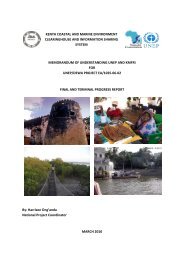
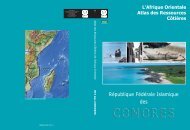
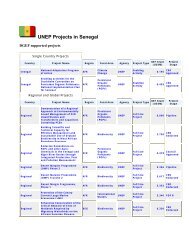

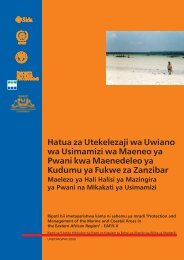
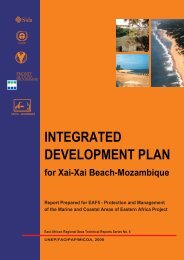
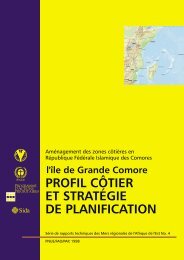
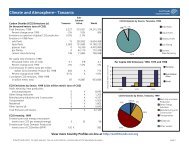

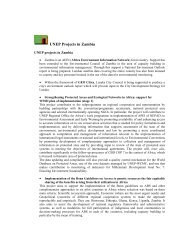
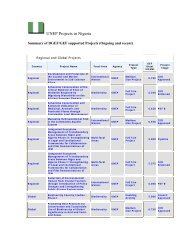
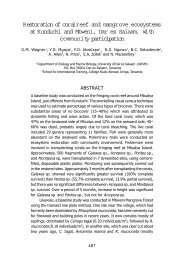
![Please Click to download [English] - GRID Africa GeoPortal - UNEP](https://img.yumpu.com/30633391/1/184x260/please-click-to-download-english-grid-africa-geoportal-unep.jpg?quality=85)
